In the western US common mullein is often referred to as “cowboy toilet paper” but chickadees use it for food. These two youngsters may have been siblings but that doesn’t mean they had to be friendly over their breakfast.
Photos taken four days ago in the Wasatch Mountains.
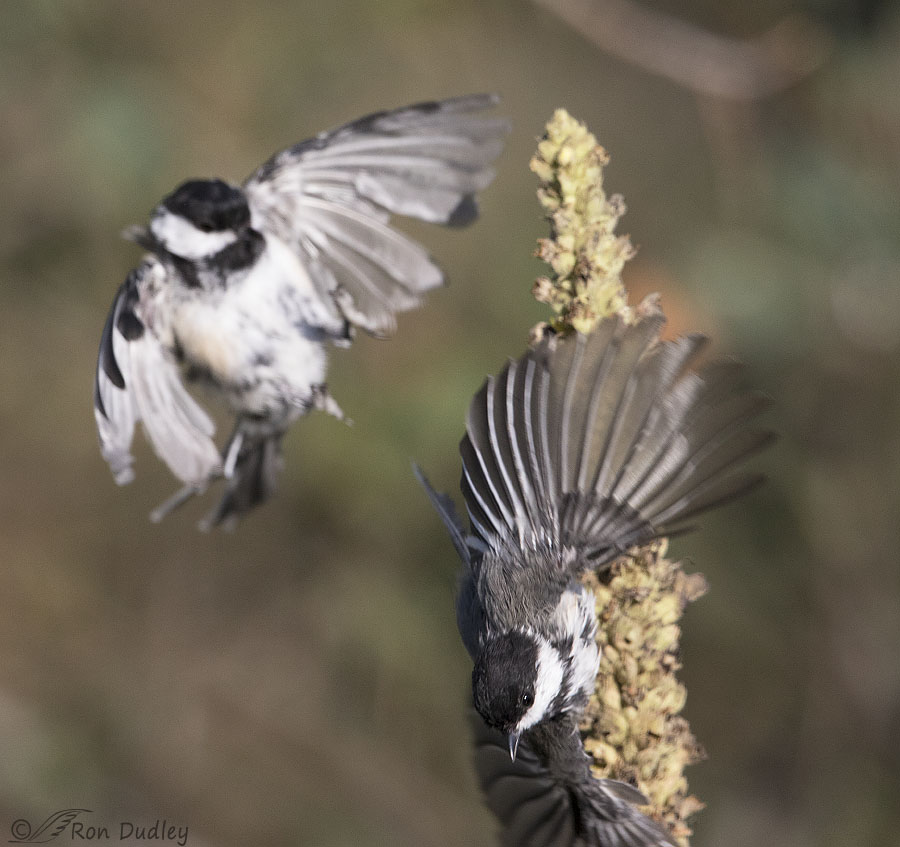
1/3200, f/6.3, ISO 800, Canon 7D Mark II, Canon EF 500mm f/4L IS II USM + EF 1.4 III Extender, not baited, set up or called in
This crappy photo is the only one I have to show their actual competition for the mullein they were squabbling over because both birds were never on the seed head at the same time. One would feed furiously for a few seconds and then the other one would chase it off and take its place. It was literally a two bird feeding frenzy for quite a while.
It was tough shooting for me though because I had to thread the needle with my lens – there was obstructing foreground vegetation on both sides of the mullein so I didn’t have much space to work with.
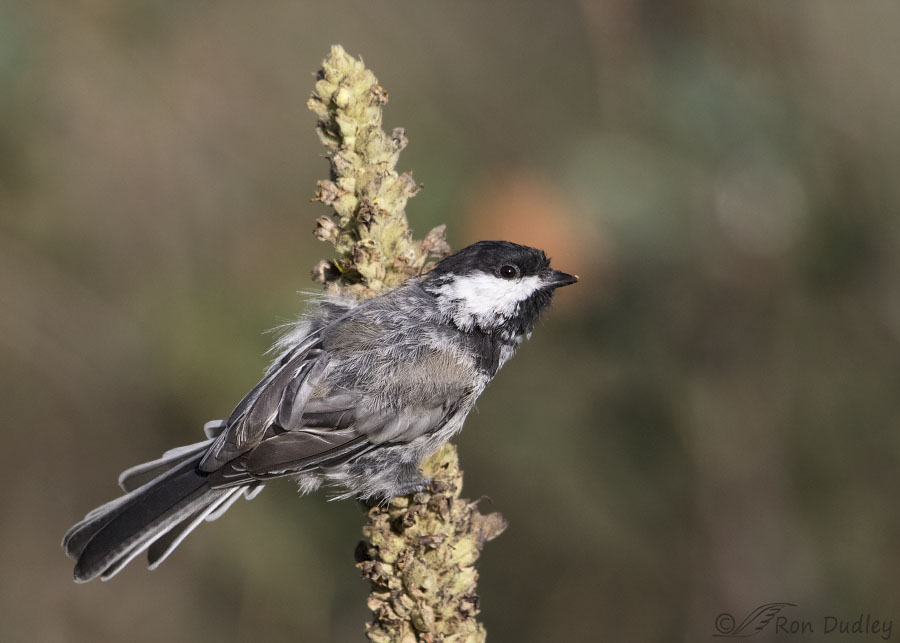
1/3200, f/6.3, ISO 800, Canon 7D Mark II, Canon EF 500mm f/4L IS II USM + EF 1.4 III Extender, not baited, set up or called in
Because they were recently fledged their plumage looked like the birds had been standing in front of a hair dryer blowing the wrong way against their feathers and as a result they looked a little “rough”.
Birds of North America Online says that chickadee down feathers as nestlings “persist and are pushed out by, and remain attached to, the juvenile feathers until worn away after the bird leaves the nest”. That explains their “rough” look at this young age and I think the explanation is pretty interesting. Some of the remnant down feathers can still be seen in this and other photos.
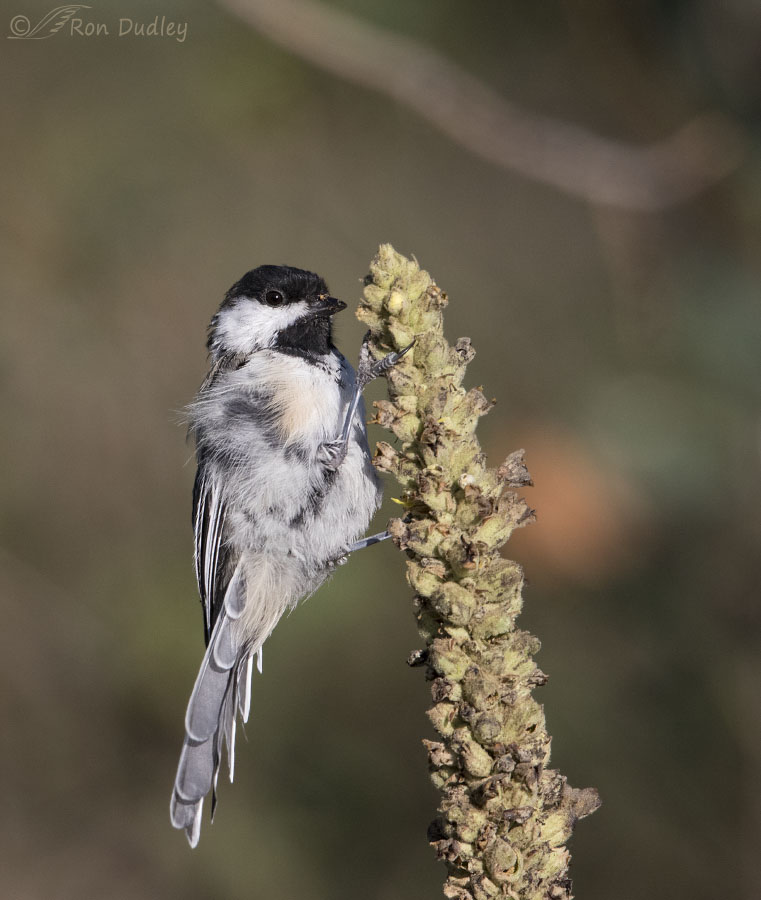
1/4000, f/6.3, ISO 800, Canon 7D Mark II, Canon EF 500mm f/4L IS II USM + EF 1.4 III Extender, not baited, set up or called in
In the short time they always had on the mullein they were concentrating on their eating with their heads facing the plant so I didn’t get many shots with a catch light or even eye contact. Somehow this one found the time to look my way for a moment.
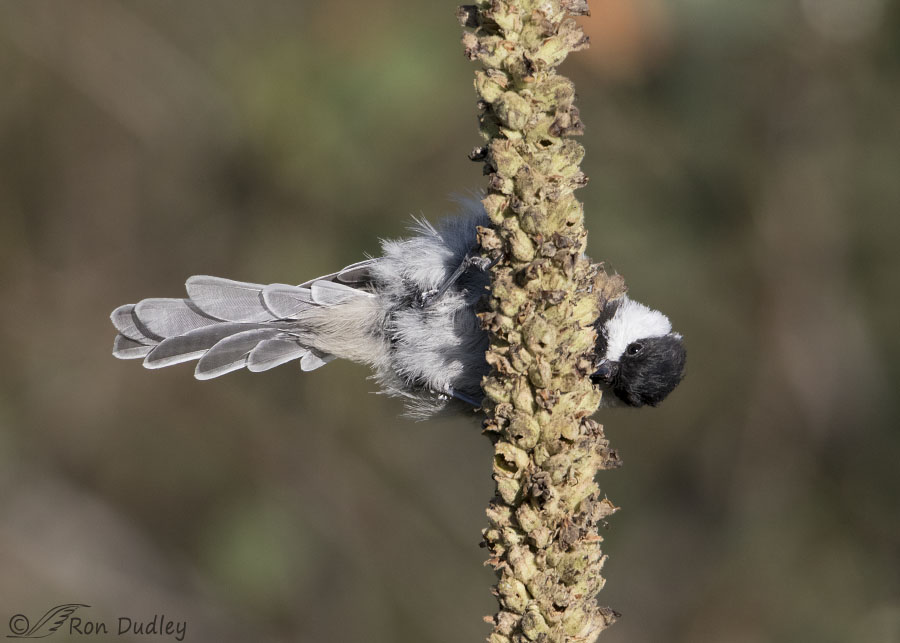
1/3200, f/6.3, ISO 800, Canon 7D Mark II, Canon EF 500mm f/4L IS II USM + EF 1.4 III Extender, not baited, set up or called in
I think their tail at this stage of development is particularly attractive. Apparently the central feathers grow longest first and the others lag behind in the order of their closeness to the center and this gives their tail at this young age an unusually handsome look in my book. According to BNA their “tails grow rapidly so that within 7–10 d of leaving the nest, young become difficult to distinguish from adults” and that suggests that at least one of these birds left the nest quite recently.
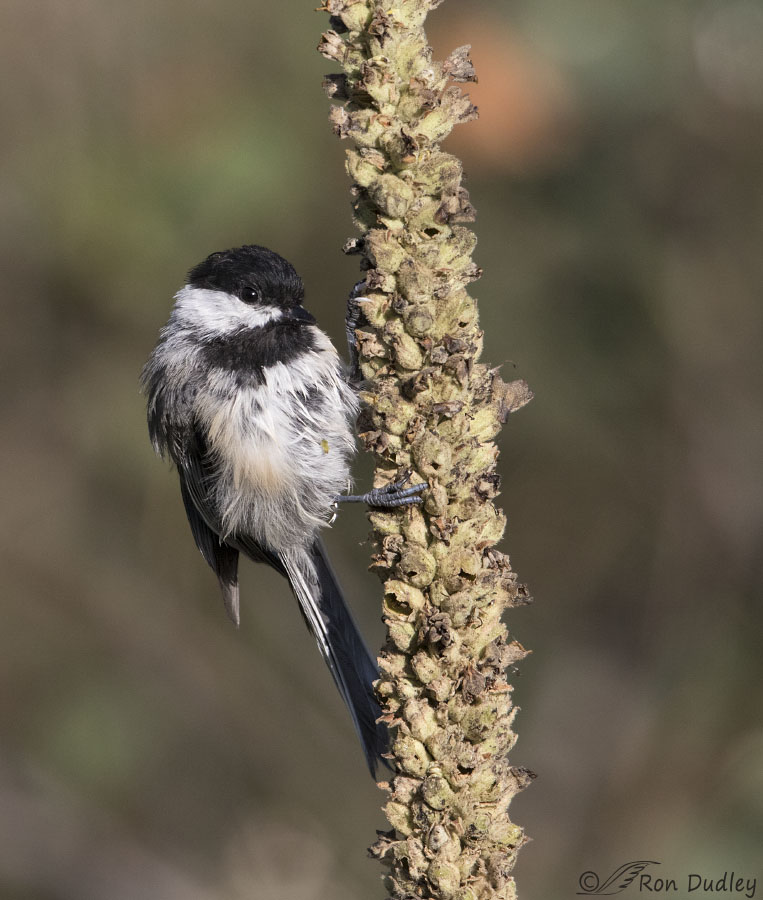
1/4000, f/6.3, ISO 800, Canon 7D Mark II, Canon EF 500mm f/4L IS II USM + EF 1.4 III Extender, not baited, set up or called in
This one gave me one of those cute coquettish looks. Maybe “she” was flirting with me…
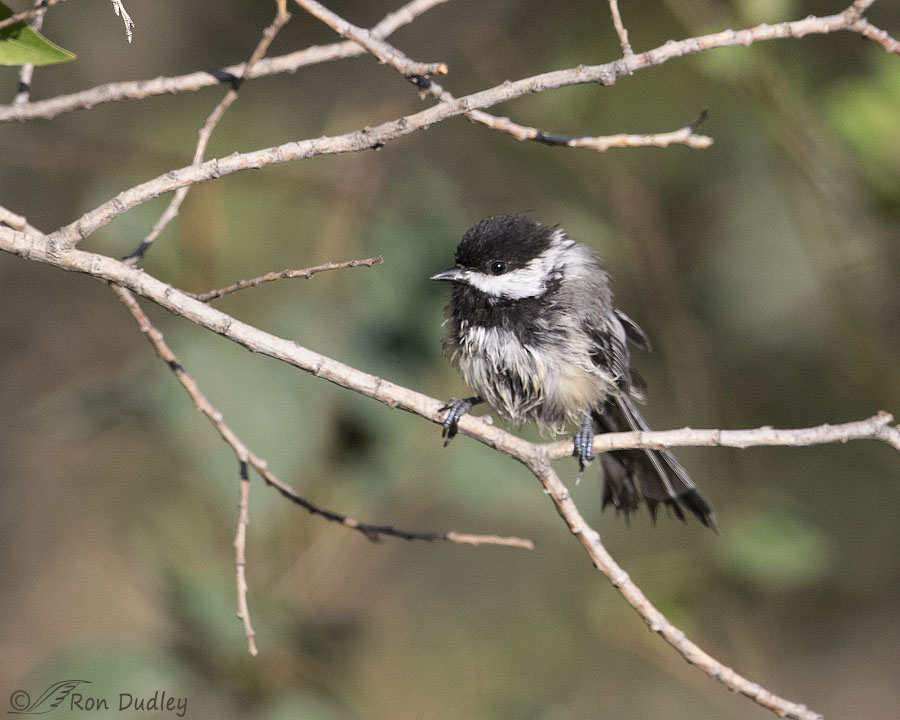
1/2500, f/6.3, ISO 800, Canon 7D Mark II, Canon EF 500mm f/4L IS II USM + EF 1.4 III Extender, not baited, set up or called in
But if juveniles look a little rough when they’re dry it doesn’t compare to their disarray when wet. There’s a seep very close by and because of its seclusion many birds were using it for bathing. But to dry off they typically came out into the sun.
This bedraggled juvie was far away but I couldn’t resist invading its privacy as it dried off after bathing.
Ron


Love. These pics and the explaination about the feathers and such. Thanks. Cute bird.
Boy, that is way different than the lumberjack toilet paper (large leaf aster) of my home state of Minnesota!
Ken
Their tails are BEAUTIFUL! What a treat to see these juveniles.
That’s a delightful set of photos. As a birder, I’m especially grateful for your photos. You always show me something I’ve never seen or never noticed. Your photos are a reminder I have to slow down and spend more time actually looking at the birds instead of just ticking them off my mental list. I have to admit sometimes that can a little hard. I know when I heard a few of them that pretty soon a mixed flock of birds will arrive, and I’ll have seven or eight species of birds around me, maybe a dozen or more birds.
One of my favorite birds….
I wonder if the chickadees become better behaved when they mature. The ones at my feeder seem to wait their turn, grab a seed, and fly off to nibble on it. I’ll have to look for the “blow-dried” youngsters. In western Washington we have thimbleberry (Rubus parvifloris), also called Indian toilet paper, and we have common mullein as well. Puts a humorous(?) spin on playing cowboys and Indians.
You’re “humorous” works for me, Lyle. And I didn’t know about that name being applied to thimbleberry.
Cowboy toilet paper? Ouch. That is an image which I really, really didn’t want imprinted so early in the day.
Fortunately (I hope) the chickadees antics have replaced the eye worm that phrase inspired.
Pecking order isn’t an empty phrase.
Love the rough look, and you are sooooo right about the beauty of that tail. And of course you were being flirted with. A star has to keep the papparazzi on side.
Ha, I guess that’s what I am, EC – part of the bird paparazzi! Thanks.
WOW! Yet another really cool series. Chickadees are right at the top of my list of favorites that goes on and on and rotates at the top, depending on who’s nearby at the moment For such tiny little beauties, they’re incredibly bold! Every time I see or hear them, I can’t help but break out in a huge smile that exceeds the width of my face! Sadly, they don’t live here. Harrumph!
For such tiny little beauties, they’re incredibly bold! Every time I see or hear them, I can’t help but break out in a huge smile that exceeds the width of my face! Sadly, they don’t live here. Harrumph!
Oh, and as for the cowboy toilet paper, I think I’d rather just wait until I got home if I didn’t go out unprepared.
Thanks, Laura.
I’d rather wait too but sometimes that just ain’t in the cards…
Not sure I agree with that Ron. Just depends on a) how much of a mess you’re willing to clean up when you get home and b) how over civilized you are! I’m going to admit to not being real civilized anymore. Then again, I’m prepared, too
wonderful photos of beautiful little — and very frenetic — birds. Don’t have them here in SoCal, but really enjoy their antics when I visit my family in northern Idaho. The growth pattern of the tail feathers is fascinating — thanks for showing us the underside! And I think I’m glad I was never a cowboy or a hunter — although I was a backpacker & hiker, but generally better-prepared for being in the woods!
Yes, being prepared is the key. The alternative can be very unpleasant. Thanks, Chris.
Beautiful series. My son calls them Velcro toed fiesty little shits. He has had a hard time living with 2 rehabbers.
Ha, that’s funny, April. And yes, I’ll bet it’s a bit of a challenge.
What a wonderful series! I have seen tons of Black-capped Chickadees, but never the juveniles. Even though a pair of them were nesting in a box I had put up for Wrens on my deck, back when I lived in Richmond, VA. One of my very favorite memories from that time was when one of the parents was fussing at me through the worm in it’s mouth, wanting me to get off my deck, so it could feed its youngsters (as if I didn’t know they had a nest there, and even though I was at the far end of the deck). These youngsters are beautiful, even though they are the scroungiest birds I’ve ever seen.
Ha, “scroungiest”! Another word I could have used in my text. Thanks, Susan.
Fun series. The tails are really intriguing. Almost look like a pinecone!
Thanks, Arwen.
Absolute cuteness! And yes that tail is beautiful! Terrific series in the life of a chickadee. The ‘wet one’ is special I learned a lot today with this post! I must be honest and say I don’t think I’ve ever seen a fledgling chickadee…perhaps they don’t come to feeders until they are a bit older; they do move further out into the woods for nesting though as I will hear them as I’m out driving. For such a tiny bird they are so fiercely competitive…I rarely see two come into a feeder at the same time and then it is ‘chase away time’ before they grab and go. Something I find interesting and it is not only with chickadees but it seems most of the small birds will chase a ‘like species’ away from the feeder but will ignore other species there. Can’t understand the reasoning there…
Oh yes…I’ve heard of the mullein leaves as ‘hunter’s toilet paper!
I’ve never heard that version, Kathy – though it makes sense.
Reminds me of a story one of my teaching colleagues used to tell (Moroni Schwab – a driver’s ed teacher at South High). He grew up on a farm near Bear Lake on the Utah/Idaho border and as a young kid while he was wandering around in the hills he once used stinging nettle as a toilet paper substitute. His description of the results used to have the entire faculty room roaring with laughter.
“Can’t understand the reasoning there”
Perhaps it’s instinctive, Kathy – based on the assumption that the same species would be after the same food type they are, though that possibility makes more sense in a wild situation than it might at a feeder. Just a wild guess…
Such beautiful little critters, even when “bedraggled”,,,,,,,,the things one learns on your blog ! I never heard that name for mullein- I’m hoping it refers
to the leaves==rather large, as I remember–and not the stalks ( ouch ! )
Yup, they used the leaves for that purpose, Kris. The other option makes me cringe…
Thank you Ron, very interesting to learn about juvenile chickadees and beautifully illustrated, as always. I love seeing those tail feathers in the 2nd and 3rd shots too (I will be looking out for these details in appearance as clues to how young chickadees are in future!)
Thanks, D. I think their tails at this age are really neat-looking. They remind me a little of magpie tails when they’re flared.